Jingyu Li
MSR-Codec: A Low-Bitrate Multi-Stream Residual Codec for High-Fidelity Speech Generation with Information Disentanglement
Sep 16, 2025Abstract:Audio codecs are a critical component of modern speech generation systems. This paper introduces a low-bitrate, multi-scale residual codec that encodes speech into four distinct streams: semantic, timbre, prosody, and residual. This architecture achieves high-fidelity speech reconstruction at competitive low bitrates while demonstrating an inherent ability for information disentanglement. We construct a two-stage language model for text-to-speech (TTS) synthesis using this codec, which, despite its lightweight design and minimal data requirements, achieves a state-of-the-art Word Error Rate (WER) and superior speaker similarity compared to several larger models. Furthermore, the codec's design proves highly effective for voice conversion, enabling independent manipulation of speaker timbre and prosody.
Emotion Omni: Enabling Empathetic Speech Response Generation through Large Language Models
Aug 26, 2025Abstract:With the development of speech large language models (speech LLMs), users can now interact directly with assistants via speech. However, most existing models simply convert the response content into speech without fully understanding the rich emotional and paralinguistic cues embedded in the user's query. In many cases, the same sentence can have different meanings depending on the emotional expression. Furthermore, emotional understanding is essential for improving user experience in human-machine interaction. Currently, most speech LLMs with empathetic capabilities are trained on massive datasets. This approach requires vast amounts of data and significant computational resources. Therefore, a key challenge lies in how to develop a speech LLM capable of generating empathetic responses with limited data and without the need for large-scale training. To address this challenge, we propose Emotion Omni, a novel model architecture designed to understand the emotional content of user speech input and generate empathetic speech responses. Additionally, we developed a data generation pipeline based on an open-source TTS framework to construct a 200k emotional dialogue dataset, which supports the construction of an empathetic speech assistant. The demos are available at https://w311411.github.io/omni_demo/
RealEngine: Simulating Autonomous Driving in Realistic Context
May 22, 2025Abstract:Driving simulation plays a crucial role in developing reliable driving agents by providing controlled, evaluative environments. To enable meaningful assessments, a high-quality driving simulator must satisfy several key requirements: multi-modal sensing capabilities (e.g., camera and LiDAR) with realistic scene rendering to minimize observational discrepancies; closed-loop evaluation to support free-form trajectory behaviors; highly diverse traffic scenarios for thorough evaluation; multi-agent cooperation to capture interaction dynamics; and high computational efficiency to ensure affordability and scalability. However, existing simulators and benchmarks fail to comprehensively meet these fundamental criteria. To bridge this gap, this paper introduces RealEngine, a novel driving simulation framework that holistically integrates 3D scene reconstruction and novel view synthesis techniques to achieve realistic and flexible closed-loop simulation in the driving context. By leveraging real-world multi-modal sensor data, RealEngine reconstructs background scenes and foreground traffic participants separately, allowing for highly diverse and realistic traffic scenarios through flexible scene composition. This synergistic fusion of scene reconstruction and view synthesis enables photorealistic rendering across multiple sensor modalities, ensuring both perceptual fidelity and geometric accuracy. Building upon this environment, RealEngine supports three essential driving simulation categories: non-reactive simulation, safety testing, and multi-agent interaction, collectively forming a reliable and comprehensive benchmark for evaluating the real-world performance of driving agents.
MetaSTH-Sleep: Towards Effective Few-Shot Sleep Stage Classification with Spatial-Temporal Hypergraph Enhanced Meta-Learning
May 22, 2025Abstract:Accurate classification of sleep stages based on bio-signals is fundamental for automatic sleep stage annotation. Traditionally, this task relies on experienced clinicians to manually annotate data, a process that is both time-consuming and labor-intensive. In recent years, deep learning methods have shown promise in automating this task. However, three major challenges remain: (1) deep learning models typically require large-scale labeled datasets, making them less effective in real-world settings where annotated data is limited; (2) significant inter-individual variability in bio-signals often results in inconsistent model performance when applied to new subjects, limiting generalization; and (3) existing approaches often overlook the high-order relationships among bio-signals, failing to simultaneously capture signal heterogeneity and spatial-temporal dependencies. To address these issues, we propose MetaSTH-Sleep, a few-shot sleep stage classification framework based on spatial-temporal hypergraph enhanced meta-learning. Our approach enables rapid adaptation to new subjects using only a few labeled samples, while the hypergraph structure effectively models complex spatial interconnections and temporal dynamics simultaneously in EEG signals. Experimental results demonstrate that MetaSTH-Sleep achieves substantial performance improvements across diverse subjects, offering valuable insights to support clinicians in sleep stage annotation.
Composed Multi-modal Retrieval: A Survey of Approaches and Applications
Mar 03, 2025



Abstract:With the rapid growth of multi-modal data from social media, short video platforms, and e-commerce, content-based retrieval has become essential for efficiently searching and utilizing heterogeneous information. Over time, retrieval techniques have evolved from Unimodal Retrieval (UR) to Cross-modal Retrieval (CR) and, more recently, to Composed Multi-modal Retrieval (CMR). CMR enables users to retrieve images or videos by integrating a reference visual input with textual modifications, enhancing search flexibility and precision. This paper provides a comprehensive review of CMR, covering its fundamental challenges, technical advancements, and categorization into supervised, zero-shot, and semi-supervised learning paradigms. We discuss key research directions, including data augmentation, model architecture, and loss optimization in supervised CMR, as well as transformation frameworks and external knowledge integration in zero-shot CMR. Additionally, we highlight the application potential of CMR in composed image retrieval, video retrieval, and person retrieval, which have significant implications for e-commerce, online search, and public security. Given its ability to refine and personalize search experiences, CMR is poised to become a pivotal technology in next-generation retrieval systems. A curated list of related works and resources is available at: https://github.com/kkzhang95/Awesome-Composed-Multi-modal-Retrieval
UI-TARS: Pioneering Automated GUI Interaction with Native Agents
Jan 21, 2025Abstract:This paper introduces UI-TARS, a native GUI agent model that solely perceives the screenshots as input and performs human-like interactions (e.g., keyboard and mouse operations). Unlike prevailing agent frameworks that depend on heavily wrapped commercial models (e.g., GPT-4o) with expert-crafted prompts and workflows, UI-TARS is an end-to-end model that outperforms these sophisticated frameworks. Experiments demonstrate its superior performance: UI-TARS achieves SOTA performance in 10+ GUI agent benchmarks evaluating perception, grounding, and GUI task execution. Notably, in the OSWorld benchmark, UI-TARS achieves scores of 24.6 with 50 steps and 22.7 with 15 steps, outperforming Claude (22.0 and 14.9 respectively). In AndroidWorld, UI-TARS achieves 46.6, surpassing GPT-4o (34.5). UI-TARS incorporates several key innovations: (1) Enhanced Perception: leveraging a large-scale dataset of GUI screenshots for context-aware understanding of UI elements and precise captioning; (2) Unified Action Modeling, which standardizes actions into a unified space across platforms and achieves precise grounding and interaction through large-scale action traces; (3) System-2 Reasoning, which incorporates deliberate reasoning into multi-step decision making, involving multiple reasoning patterns such as task decomposition, reflection thinking, milestone recognition, etc. (4) Iterative Training with Reflective Online Traces, which addresses the data bottleneck by automatically collecting, filtering, and reflectively refining new interaction traces on hundreds of virtual machines. Through iterative training and reflection tuning, UI-TARS continuously learns from its mistakes and adapts to unforeseen situations with minimal human intervention. We also analyze the evolution path of GUI agents to guide the further development of this domain.
Probing Speaker-specific Features in Speaker Representations
Jan 09, 2025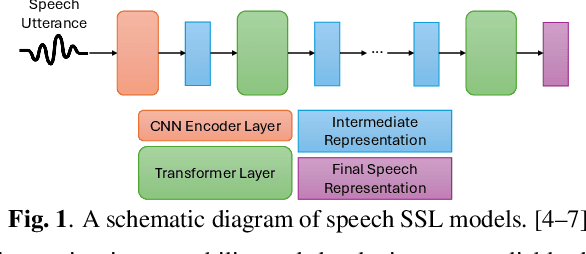
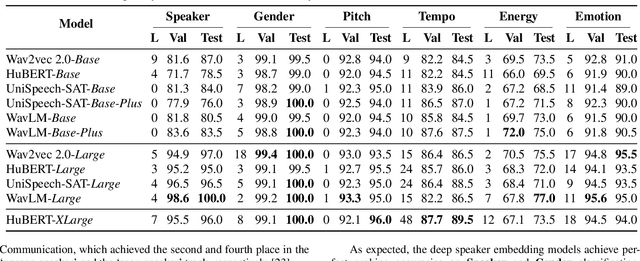
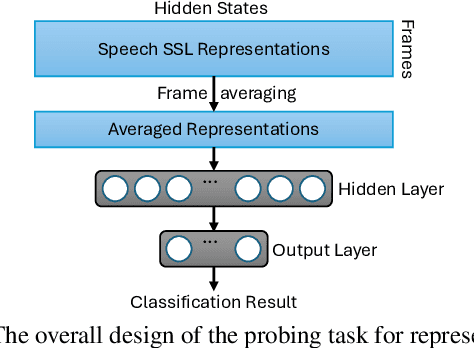
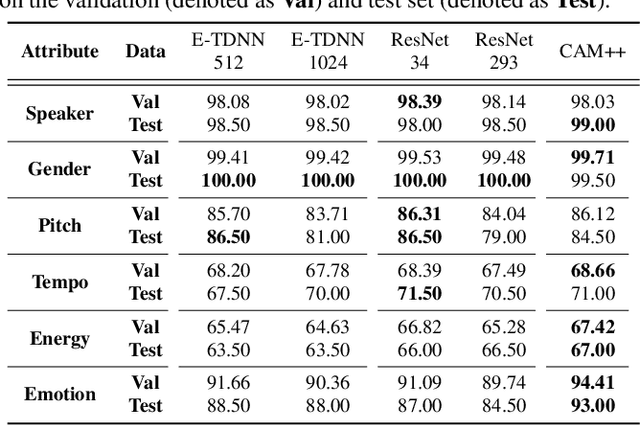
Abstract:This study explores speaker-specific features encoded in speaker embeddings and intermediate layers of speech self-supervised learning (SSL) models. By utilising a probing method, we analyse features such as pitch, tempo, and energy across prominent speaker embedding models and speech SSL models, including HuBERT, WavLM, and Wav2vec 2.0. The results reveal that speaker embeddings like CAM++ excel in energy classification, while speech SSL models demonstrate superior performance across multiple features due to their hierarchical feature encoding. Intermediate layers effectively capture a mix of acoustic and para-linguistic information, with deeper layers refining these representations. This investigation provides insights into model design and highlights the potential of these representations for downstream applications, such as speaker verification and text-to-speech synthesis, while laying the groundwork for exploring additional features and advanced probing methods.
Contrastive Representation for Interactive Recommendation
Dec 24, 2024



Abstract:Interactive Recommendation (IR) has gained significant attention recently for its capability to quickly capture dynamic interest and optimize both short and long term objectives. IR agents are typically implemented through Deep Reinforcement Learning (DRL), because DRL is inherently compatible with the dynamic nature of IR. However, DRL is currently not perfect for IR. Due to the large action space and sample inefficiency problem, training DRL recommender agents is challenging. The key point is that useful features cannot be extracted as high-quality representations for the recommender agent to optimize its policy. To tackle this problem, we propose Contrastive Representation for Interactive Recommendation (CRIR). CRIR efficiently extracts latent, high-level preference ranking features from explicit interaction, and leverages the features to enhance users' representation. Specifically, the CRIR provides representation through one representation network, and refines it through our proposed Preference Ranking Contrastive Learning (PRCL). The key insight of PRCL is that it can perform contrastive learning without relying on computations involving high-level representations or large potential action sets. Furthermore, we also propose a data exploiting mechanism and an agent training mechanism to better adapt CRIR to the DRL backbone. Extensive experiments have been carried out to show our method's superior improvement on the sample efficiency while training an DRL-based IR agent.
FairSort: Learning to Fair Rank for Personalized Recommendations in Two-Sided Platforms
Nov 30, 2024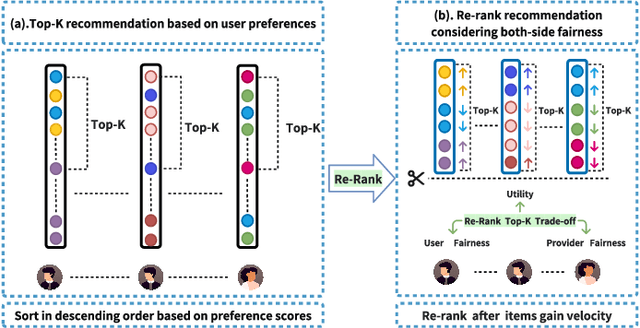


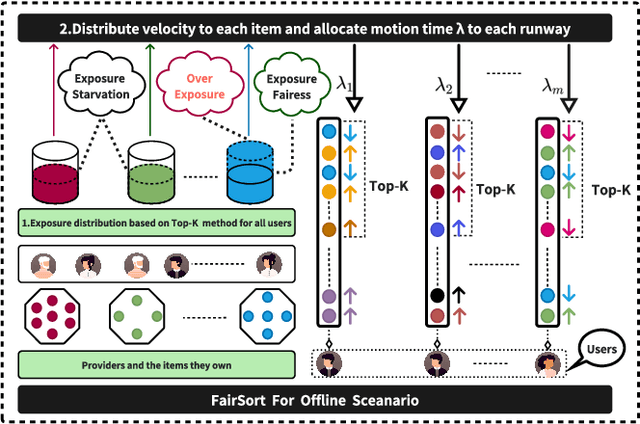
Abstract:Traditional recommendation systems focus on maximizing user satisfaction by suggesting their favorite items. This user-centric approach may lead to unfair exposure distribution among the providers. On the contrary, a provider-centric design might become unfair to the users. Therefore, this paper proposes a re-ranking model FairSort\footnote{\textbf{Reproducibility:}The code and datasets are available at \url{https://github.com/13543024276/FairSort}} to find a trade-off solution among user-side fairness, provider-side fairness, and personalized recommendations utility. Previous works habitually treat this issue as a knapsack problem, incorporating both-side fairness as constraints. In this paper, we adopt a novel perspective, treating each recommendation list as a runway rather than a knapsack. In this perspective, each item on the runway gains a velocity and runs within a specific time, achieving re-ranking for both-side fairness. Meanwhile, we ensure the Minimum Utility Guarantee for personalized recommendations by designing a Binary Search approach. This can provide more reliable recommendations compared to the conventional greedy strategy based on the knapsack problem. We further broaden the applicability of FairSort, designing two versions for online and offline recommendation scenarios. Theoretical analysis and extensive experiments on real-world datasets indicate that FairSort can ensure more reliable personalized recommendations while considering fairness for both the provider and user.
An Investigation of Reprogramming for Cross-Language Adaptation in Speaker Verification Systems
Nov 18, 2024



Abstract:Language mismatch is among the most common and challenging domain mismatches in deploying speaker verification (SV) systems. Adversarial reprogramming has shown promising results in cross-language adaptation for SV. The reprogramming is implemented by padding learnable parameters on the two sides of input speech signals. In this paper, we investigate the relationship between the number of padded parameters and the performance of the reprogrammed models. Sufficient experiments are conducted with different scales of SV models and datasets. The results demonstrate that reprogramming consistently improves the performance of cross-language SV, while the improvement is saturated or even degraded when using larger padding lengths. The performance is mainly determined by the capacity of the original SV models instead of the number of padded parameters. The SV models with larger scales have higher upper bounds in performance and can endure longer padding without performance degradation.
 Add to Chrome
Add to Chrome Add to Firefox
Add to Firefox Add to Edge
Add to Edge